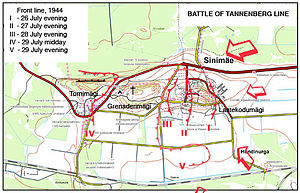
Back معركة خط تاننبرغ Arabic Emgann al linenn Tannenberg Breton Sinimägede lahing Estonian Sinimäkien taistelu Finnish Bataille de la ligne Tannenberg French Battaglia della Linea di Tannenberg Italian Bătălia de pe linia Tannenberg Romanian Рубеж «Танненберг» Russian Tannenberg Hattı Muharebesi Turkish Битва за лінію «Танненберг» Ukrainian
| Battle of Tannenberg Line | |||||||
|---|---|---|---|---|---|---|---|
| Part of Eastern Front (World War II) | |||||||
 Front line positions | |||||||
| |||||||
| Belligerents | |||||||
|
|
| ||||||
| Commanders and leaders | |||||||
|
Felix Steiner Fritz von Scholz † | Leonid Govorov | ||||||
| Units involved | |||||||
|
III (Germanic) SS Panzer Corps |
2nd Shock Army 8th Army 8th Estonian Rifle Corps | ||||||
| Strength | |||||||
|
22,250[1] 7 tanks[2][3] 70–80 assault guns[3] 49 aircraft[4][5] |
136,830 troops[6] 150 armoured vehicles[7] 1,680 assault guns[7] 546 aircraft[4][5] | ||||||
| Casualties and losses | |||||||
|
3,500[8] / 2,500[9] killed or missing 6,600[8] / 7,500[9] wounded or sick 6 tanks[7] Total: 10,100[8] / 10,000[9] |
7,700-7,800[8] / 35,000[9] killed or missing 28,000[8] / 135,000[9] wounded or sick 157–164 tanks[7] Total: 35,000[8] / 170,000[9] | ||||||
The Battle of Tannenberg Line (German: Die Schlacht um die Tannenbergstellung; Russian: Битва за линию «Танненберг») or the Battle of the Blue Hills (Estonian: Sinimägede lahing) was a military engagement between the German Army Detachment Narwa and the Soviet Leningrad Front. They fought for the strategically important Narva Isthmus from 25 July–10 August 1944. The battle was fought on the Eastern Front during World War II. The strategic aim of the Soviet Estonian Operation was to reoccupy Estonia as a favorable base for the invasions of Finland and East Prussia. Waffen-SS forces included 24 volunteer infantry battalions from the SS Division Nordland, the SS Division Langemarck, the SS Division Nederland, and the Walloon Legion. Roughly half of the infantry consisted of the personnel of the 20th Waffen Grenadier Division of the SS (1st Estonian).[10] The German force of 22,250 men held off 136,830 Soviet troops. As the Soviet forces were constantly reinforced, their overall casualties are estimated by Estonian historian Mart Laar to be 170,000 dead and wounded.
- ^ Cite error: The named reference
newtonwas invoked but never defined (see the help page). - ^ Cite error: The named reference
narwawas invoked but never defined (see the help page). - ^ a b Cite error: The named reference
laar261was invoked but never defined (see the help page). - ^ a b Cite error: The named reference
paulmanwas invoked but never defined (see the help page). - ^ a b Cite error: The named reference
hiiowas invoked but never defined (see the help page). - ^ G.F.Krivosheev (1997). Soviet casualties and combat losses in the twentieth century. London: Greenhill Books.
- ^ a b c d Cite error: The named reference
laarwas invoked but never defined (see the help page). - ^ a b c d e f Astafjev, Artjom; Kütt, Andrus; Rosenthal, Reigo (2015). "Vastaspoolte inimkaotustest Narva rindel 1944. aasta 24. juulist kuni 7. augustini (Narva ja Sinimägede lahingud)" [About the human losses of the opposing sides on the Narva front from July 24 to August 7, 1944 (the battles of Narva and Sinimäge)]. Tuna (in Estonian) (4): 67–73.
- ^ a b c d e f Cite error: The named reference
laar326was invoked but never defined (see the help page). - ^ Mole, Richard C. M. (2012). The Baltic States from the Soviet Union to the European Union. Routledge. p. 48. ISBN 9780415394970.
© MMXXIII Rich X Search. We shall prevail. All rights reserved. Rich X Search